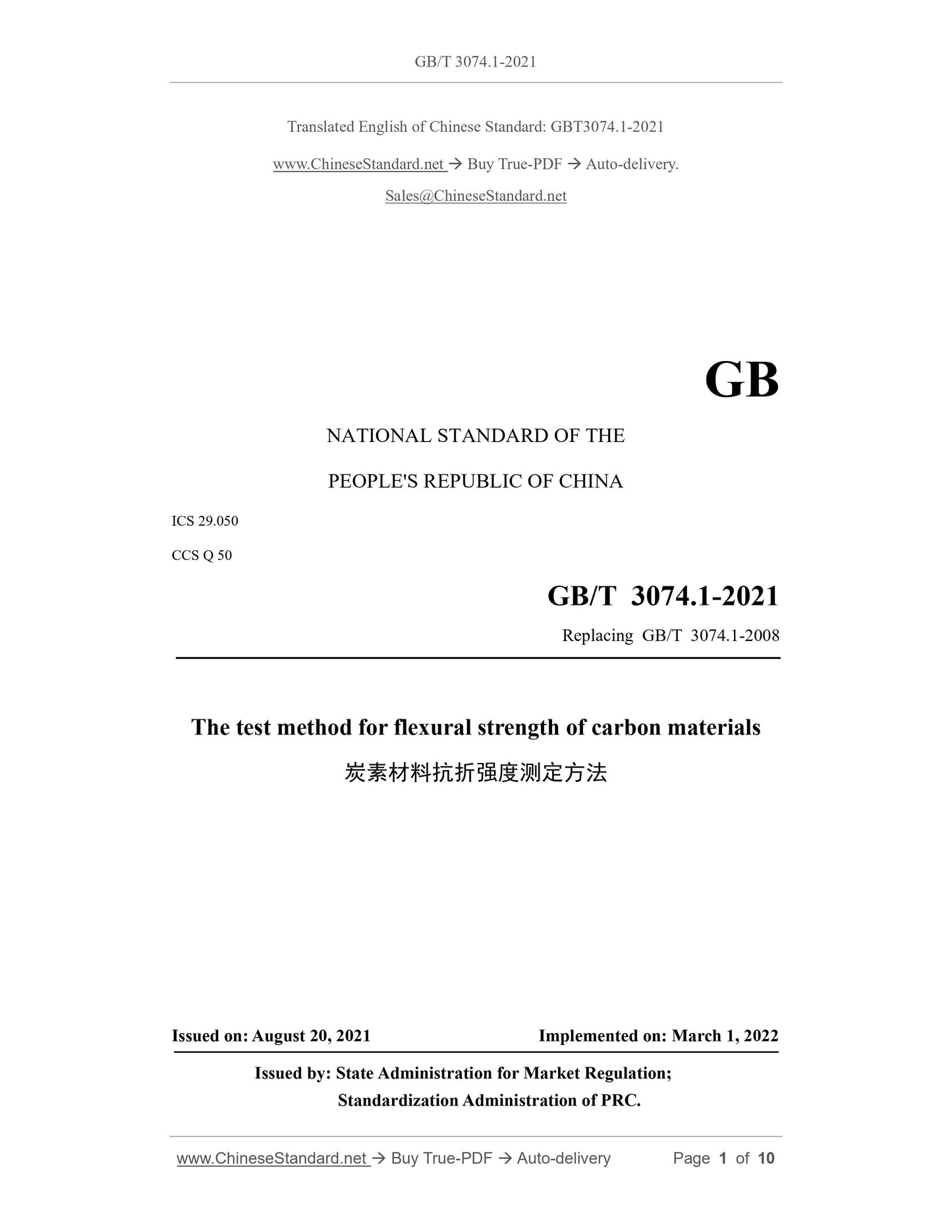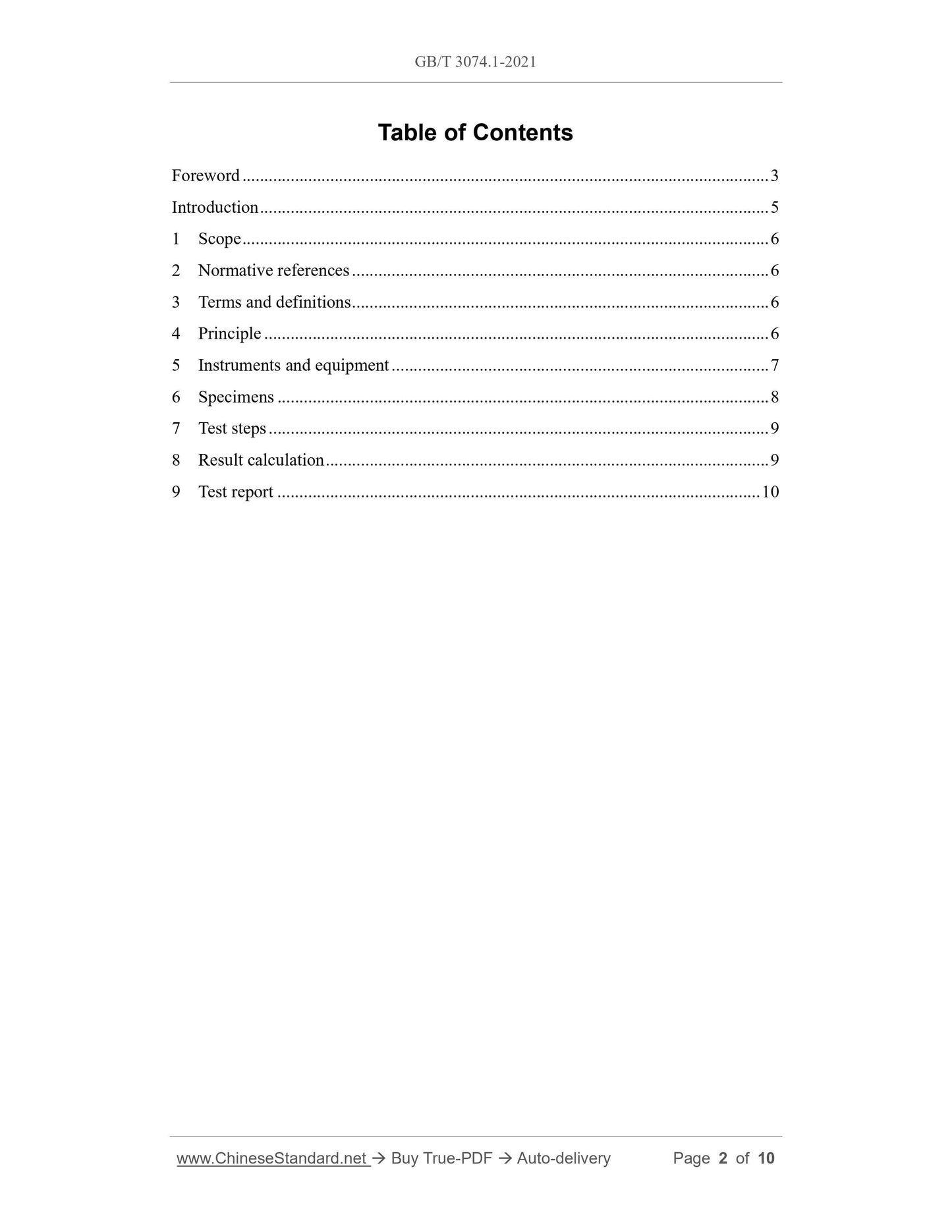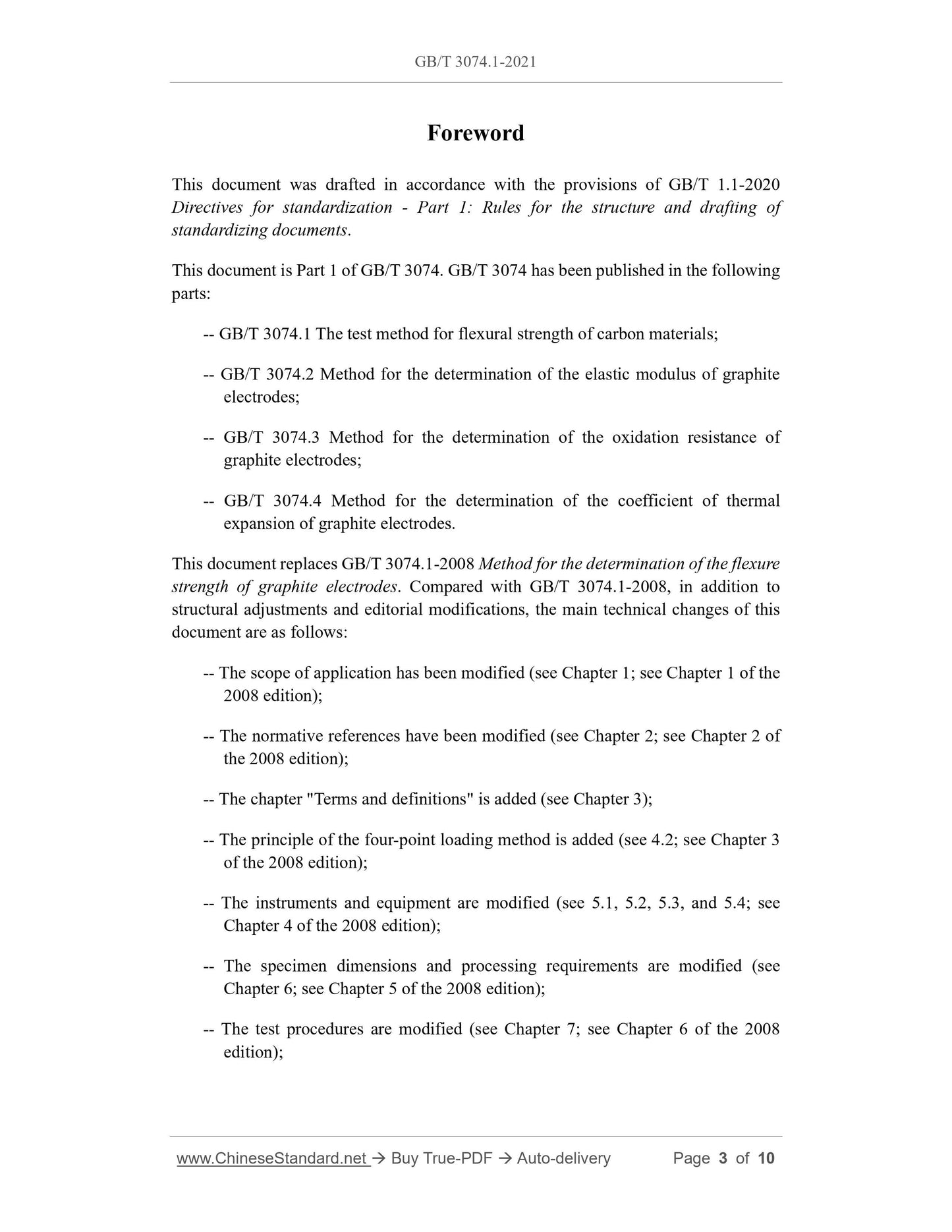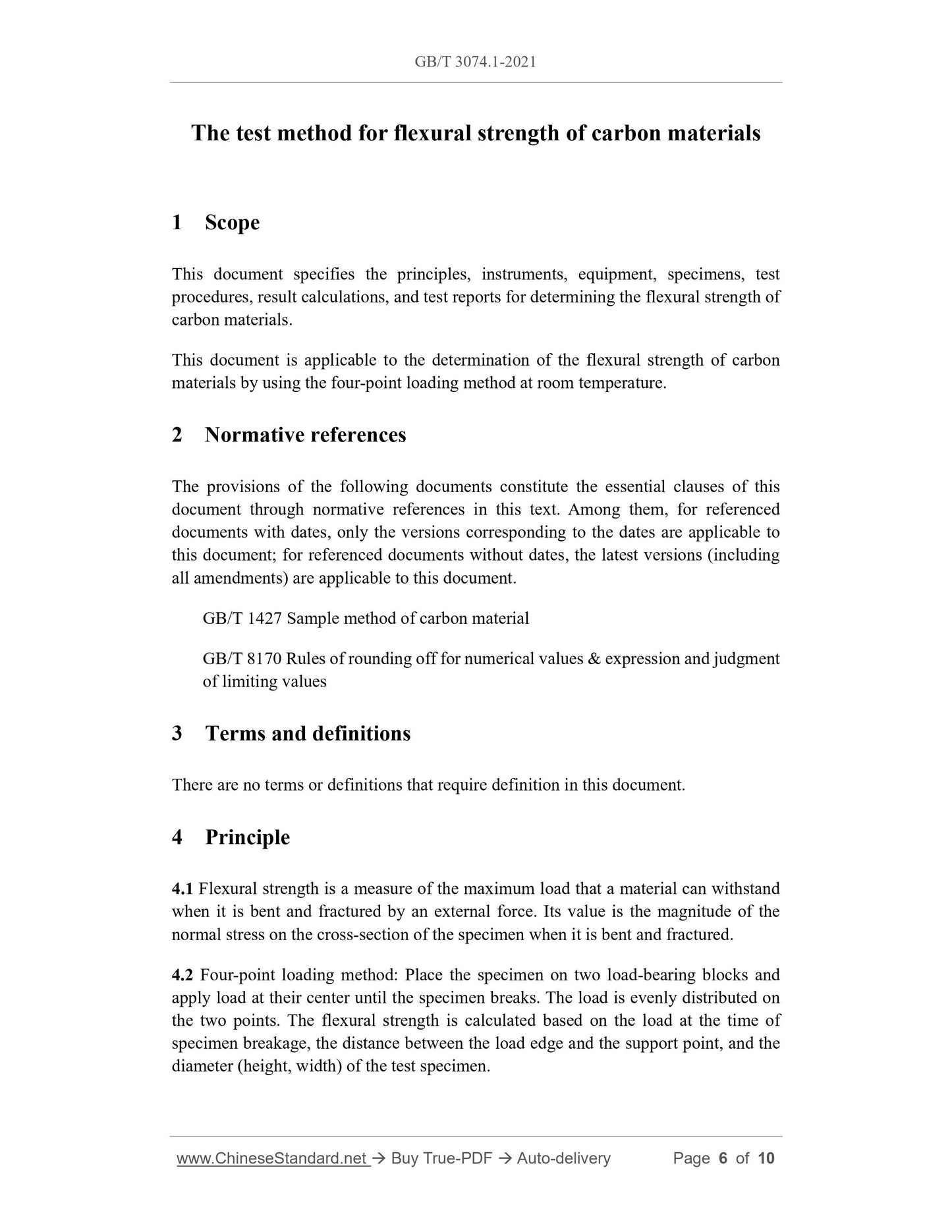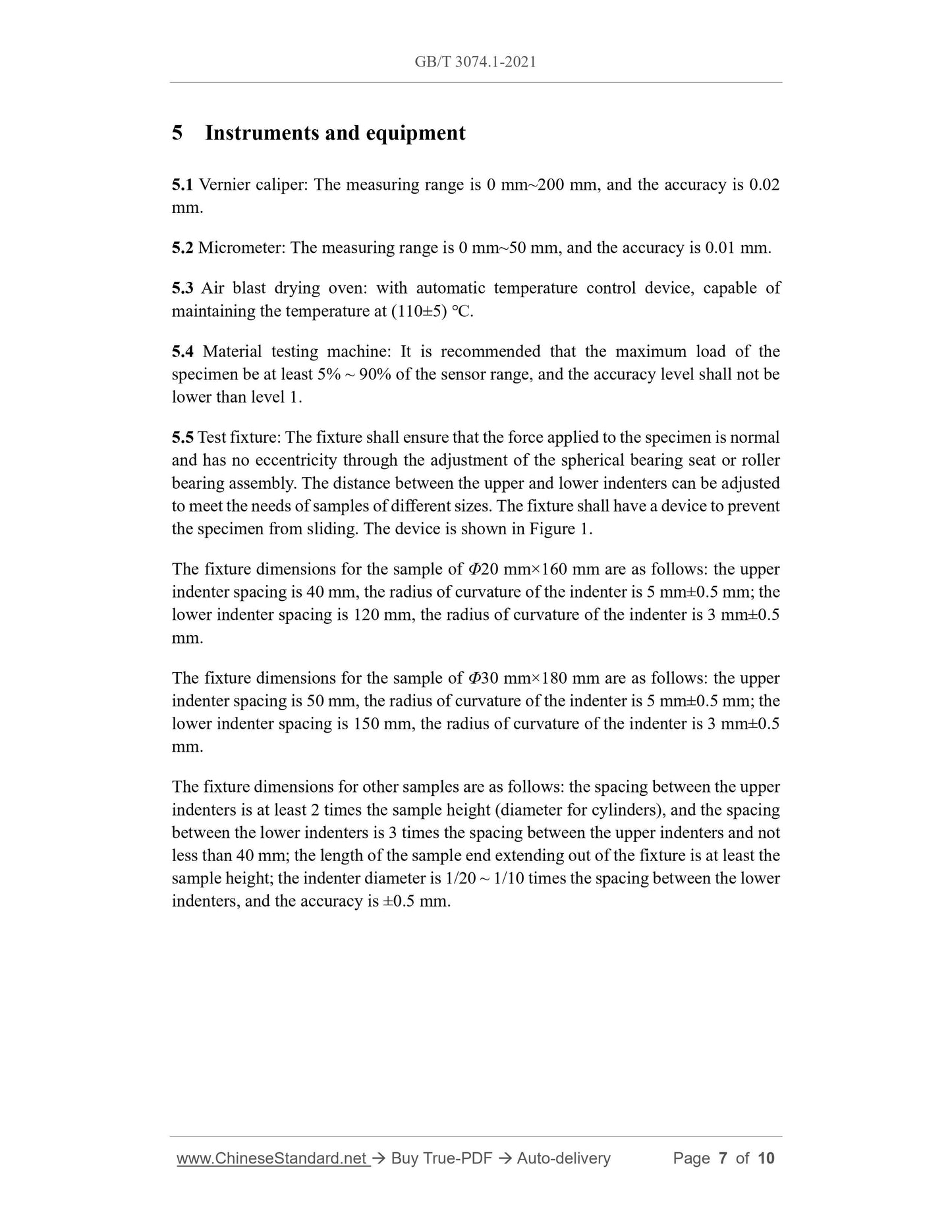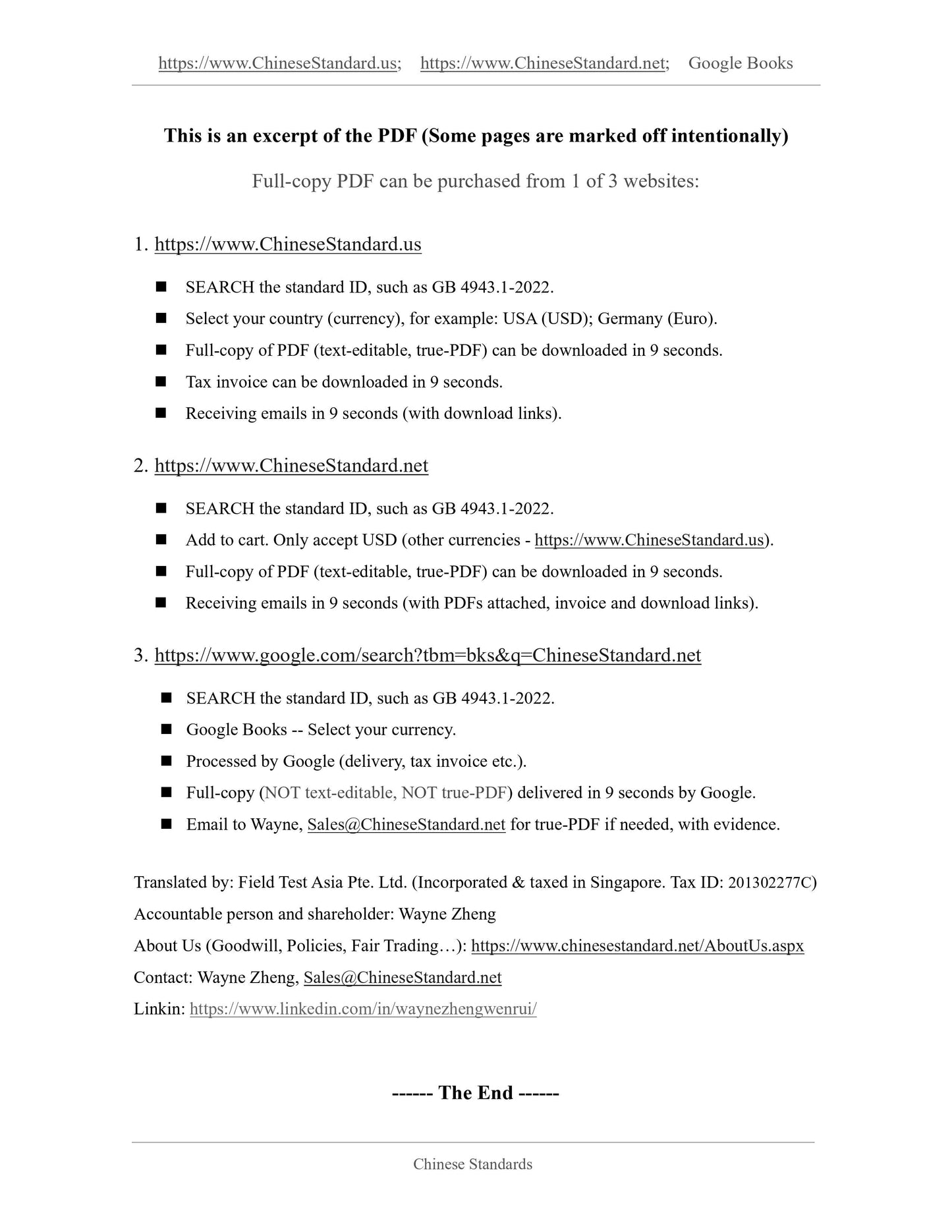1
/
of
6
www.ChineseStandard.us -- Field Test Asia Pte. Ltd.
GB/T 3074.1-2021 English PDF (GB/T3074.1-2021)
GB/T 3074.1-2021 English PDF (GB/T3074.1-2021)
Regular price
$110.00
Regular price
Sale price
$110.00
Unit price
/
per
Shipping calculated at checkout.
Couldn't load pickup availability
GB/T 3074.1-2021: The test method for flexural strength of carbon materials
Delivery: 9 seconds. Download (& Email) true-PDF + Invoice.
Get Quotation: Click GB/T 3074.1-2021 (Self-service in 1-minute)
Historical versions (Master-website): GB/T 3074.1-2021
Preview True-PDF (Reload/Scroll-down if blank)
GB/T 3074.1-2021
GB
NATIONAL STANDARD OF THE
PEOPLE'S REPUBLIC OF CHINA
ICS 29.050
CCS Q 50
Replacing GB/T 3074.1-2008
The test method for flexural strength of carbon materials
ISSUED ON: AUGUST 20, 2021
IMPLEMENTED ON: MARCH 1, 2022
Issued by: State Administration for Market Regulation;
Standardization Administration of PRC.
Table of Contents
Foreword ... 3
Introduction ... 5
1 Scope ... 6
2 Normative references ... 6
3 Terms and definitions ... 6
4 Principle ... 6
5 Instruments and equipment ... 7
6 Specimens ... 8
7 Test steps ... 9
8 Result calculation ... 9
9 Test report ... 10
Foreword
This document was drafted in accordance with the provisions of GB/T 1.1-2020
Directives for standardization - Part 1: Rules for the structure and drafting of
standardizing documents.
This document is Part 1 of GB/T 3074. GB/T 3074 has been published in the following
parts:
-- GB/T 3074.1 The test method for flexural strength of carbon materials;
-- GB/T 3074.2 Method for the determination of the elastic modulus of graphite
electrodes;
-- GB/T 3074.3 Method for the determination of the oxidation resistance of
graphite electrodes;
-- GB/T 3074.4 Method for the determination of the coefficient of thermal
expansion of graphite electrodes.
This document replaces GB/T 3074.1-2008 Method for the determination of the flexure
strength of graphite electrodes. Compared with GB/T 3074.1-2008, in addition to
structural adjustments and editorial modifications, the main technical changes of this
document are as follows:
-- The scope of application has been modified (see Chapter 1; see Chapter 1 of the
2008 edition);
-- The normative references have been modified (see Chapter 2; see Chapter 2 of
the 2008 edition);
-- The chapter "Terms and definitions" is added (see Chapter 3);
-- The principle of the four-point loading method is added (see 4.2; see Chapter 3
of the 2008 edition);
-- The instruments and equipment are modified (see 5.1, 5.2, 5.3, and 5.4; see
Chapter 4 of the 2008 edition);
-- The specimen dimensions and processing requirements are modified (see
Chapter 6; see Chapter 5 of the 2008 edition);
-- The test procedures are modified (see Chapter 7; see Chapter 6 of the 2008
edition);
The test method for flexural strength of carbon materials
1 Scope
This document specifies the principles, instruments, equipment, specimens, test
procedures, result calculations, and test reports for determining the flexural strength of
carbon materials.
This document is applicable to the determination of the flexural strength of carbon
materials by using the four-point loading method at room temperature.
2 Normative references
The provisions of the following documents constitute the essential clauses of this
document through normative references in this text. Among them, for referenced
documents with dates, only the versions corresponding to the dates are applicable to
this document; for referenced documents without dates, the latest versions (including
all amendments) are applicable to this document.
GB/T 1427 Sample method of carbon material
GB/T 8170 Rules of rounding off for numerical values and expression and judgment
of limiting values
3 Terms and definitions
There are no terms or definitions that require definition in this document.
4 Principle
4.1 Flexural strength is a measure of the maximum load that a material can withstand
when it is bent and fractured by an external force. Its value is the magnitude of the
normal stress on the cross-section of the specimen when it is bent and fractured.
4.2 Four-point loading method: Place the specimen on two load-bearing blocks and
apply load at their center until the specimen breaks. The load is evenly distributed on
the two points. The flexural strength is calculated based on the load at the time of
specimen breakage, the distance between the load edge and the support point, and the
diameter (height, width) of the test specimen.
5 Instruments and equipment
5.1 Vernier caliper: The measuring range is 0 mm~200 mm, and the accuracy is 0.02
mm.
5.2 Micrometer: The measuring range is 0 mm~50 mm, and the accuracy is 0.01 mm.
5.3 Air blast drying oven: with automatic temperature control device, capable of
maintaining the temperature at (110±5) ℃.
5.4 Material testing machine: It is recommended that the maximum load of the
specimen be at least 5% ~ 90% of the sensor range, and the accuracy level shall not be
lower than level 1.
5.5 Test fixture: The fixture shall ensure that the force applied to the specimen is normal
and has no eccentricity through the adjustment of the spherical bearing seat or roller
bearing assembly. The distance between the upper and lower indenters can be adjusted
to meet the needs of samples of different sizes. The fixture shall have a device to prevent
the specimen from sliding. The device is shown in Figure 1.
The fixture dimensions for the sample of Φ20 mm×160 mm are as follows: the upper
indenter spacing is 40 mm, the radius of curvature of the indenter is 5 mm±0.5 mm; the
lower indenter spacing is 120 mm, the radius of curvature of the indenter is 3 mm±0.5
mm.
The fixture dimensions for the sample of Φ30 mm×180 mm are as follows: the upper
indenter spacing is 50 mm, the radius of curvature of the indenter is 5 mm±0.5 mm; the
lower indenter spacing is 150 mm, the radius of curvature of the indenter is 3 mm±0.5
mm.
The fixture dimensions for other samples are as follows: the spacing between the upper
indenters is at least 2 times the sample height (diameter for cylinders), and the spacing
between the lower indenters is 3 times the spacing between the upper indenters and not
less than 40 mm; the length of the sample end extending out of the fixture is at least the
sample height; the indenter diameter is 1/20 ~ 1/10 times the spacing between the lower
indenters, and the accuracy is ±0.5 mm.
GB/T 3074.1-2021
GB
NATIONAL STANDARD OF THE
PEOPLE'S REPUBLIC OF CHINA
ICS 29.050
CCS Q 50
Replacing GB/T 3074.1-2008
The test method for flexural strength of carbon materials
ISSUED ON: AUGUST 20, 2021
IMPLEMENTED ON: MARCH 1, 2022
Issued by: State Administration for Market Regulation;
Standardization Administration of PRC.
Table of Contents
Foreword ... 3
Introduction ... 5
1 Scope ... 6
2 Normative references ... 6
3 Terms and definitions ... 6
4 Principle ... 6
5 Instruments and equipment ... 7
6 Specimens ... 8
7 Test steps ... 9
8 Result calculation ... 9
9 Test report ... 10
Foreword
This document was drafted in accordance with the provisions of GB/T 1.1-2020
Directives for standardization - Part 1: Rules for the structure and drafting of
standardizing documents.
This document is Part 1 of GB/T 3074. GB/T 3074 has been published in the following
parts:
-- GB/T 3074.1 The test method for flexural strength of carbon materials;
-- GB/T 3074.2 Method for the determination of the elastic modulus of graphite
electrodes;
-- GB/T 3074.3 Method for the determination of the oxidation resistance of
graphite electrodes;
-- GB/T 3074.4 Method for the determination of the coefficient of thermal
expansion of graphite electrodes.
This document replaces GB/T 3074.1-2008 Method for the determination of the flexure
strength of graphite electrodes. Compared with GB/T 3074.1-2008, in addition to
structural adjustments and editorial modifications, the main technical changes of this
document are as follows:
-- The scope of application has been modified (see Chapter 1; see Chapter 1 of the
2008 edition);
-- The normative references have been modified (see Chapter 2; see Chapter 2 of
the 2008 edition);
-- The chapter "Terms and definitions" is added (see Chapter 3);
-- The principle of the four-point loading method is added (see 4.2; see Chapter 3
of the 2008 edition);
-- The instruments and equipment are modified (see 5.1, 5.2, 5.3, and 5.4; see
Chapter 4 of the 2008 edition);
-- The specimen dimensions and processing requirements are modified (see
Chapter 6; see Chapter 5 of the 2008 edition);
-- The test procedures are modified (see Chapter 7; see Chapter 6 of the 2008
edition);
The test method for flexural strength of carbon materials
1 Scope
This document specifies the principles, instruments, equipment, specimens, test
procedures, result calculations, and test reports for determining the flexural strength of
carbon materials.
This document is applicable to the determination of the flexural strength of carbon
materials by using the four-point loading method at room temperature.
2 Normative references
The provisions of the following documents constitute the essential clauses of this
document through normative references in this text. Among them, for referenced
documents with dates, only the versions corresponding to the dates are applicable to
this document; for referenced documents without dates, the latest versions (including
all amendments) are applicable to this document.
GB/T 1427 Sample method of carbon material
GB/T 8170 Rules of rounding off for numerical values and expression and judgment
of limiting values
3 Terms and definitions
There are no terms or definitions that require definition in this document.
4 Principle
4.1 Flexural strength is a measure of the maximum load that a material can withstand
when it is bent and fractured by an external force. Its value is the magnitude of the
normal stress on the cross-section of the specimen when it is bent and fractured.
4.2 Four-point loading method: Place the specimen on two load-bearing blocks and
apply load at their center until the specimen breaks. The load is evenly distributed on
the two points. The flexural strength is calculated based on the load at the time of
specimen breakage, the distance between the load edge and the support point, and the
diameter (height, width) of the test specimen.
5 Instruments and equipment
5.1 Vernier caliper: The measuring range is 0 mm~200 mm, and the accuracy is 0.02
mm.
5.2 Micrometer: The measuring range is 0 mm~50 mm, and the accuracy is 0.01 mm.
5.3 Air blast drying oven: with automatic temperature control device, capable of
maintaining the temperature at (110±5) ℃.
5.4 Material testing machine: It is recommended that the maximum load of the
specimen be at least 5% ~ 90% of the sensor range, and the accuracy level shall not be
lower than level 1.
5.5 Test fixture: The fixture shall ensure that the force applied to the specimen is normal
and has no eccentricity through the adjustment of the spherical bearing seat or roller
bearing assembly. The distance between the upper and lower indenters can be adjusted
to meet the needs of samples of different sizes. The fixture shall have a device to prevent
the specimen from sliding. The device is shown in Figure 1.
The fixture dimensions for the sample of Φ20 mm×160 mm are as follows: the upper
indenter spacing is 40 mm, the radius of curvature of the indenter is 5 mm±0.5 mm; the
lower indenter spacing is 120 mm, the radius of curvature of the indenter is 3 mm±0.5
mm.
The fixture dimensions for the sample of Φ30 mm×180 mm are as follows: the upper
indenter spacing is 50 mm, the radius of curvature of the indenter is 5 mm±0.5 mm; the
lower indenter spacing is 150 mm, the radius of curvature of the indenter is 3 mm±0.5
mm.
The fixture dimensions for other samples are as follows: the spacing between the upper
indenters is at least 2 times the sample height (diameter for cylinders), and the spacing
between the lower indenters is 3 times the spacing between the upper indenters and not
less than 40 mm; the length of the sample end extending out of the fixture is at least the
sample height; the indenter diameter is 1/20 ~ 1/10 times the spacing between the lower
indenters, and the accuracy is ±0.5 mm.
Delivery: 9 seconds. Download (& Email) true-PDF + Invoice.
Get Quotation: Click GB/T 3074.1-2021 (Self-service in 1-minute)
Historical versions (Master-website): GB/T 3074.1-2021
Preview True-PDF (Reload/Scroll-down if blank)
GB/T 3074.1-2021
GB
NATIONAL STANDARD OF THE
PEOPLE'S REPUBLIC OF CHINA
ICS 29.050
CCS Q 50
Replacing GB/T 3074.1-2008
The test method for flexural strength of carbon materials
ISSUED ON: AUGUST 20, 2021
IMPLEMENTED ON: MARCH 1, 2022
Issued by: State Administration for Market Regulation;
Standardization Administration of PRC.
Table of Contents
Foreword ... 3
Introduction ... 5
1 Scope ... 6
2 Normative references ... 6
3 Terms and definitions ... 6
4 Principle ... 6
5 Instruments and equipment ... 7
6 Specimens ... 8
7 Test steps ... 9
8 Result calculation ... 9
9 Test report ... 10
Foreword
This document was drafted in accordance with the provisions of GB/T 1.1-2020
Directives for standardization - Part 1: Rules for the structure and drafting of
standardizing documents.
This document is Part 1 of GB/T 3074. GB/T 3074 has been published in the following
parts:
-- GB/T 3074.1 The test method for flexural strength of carbon materials;
-- GB/T 3074.2 Method for the determination of the elastic modulus of graphite
electrodes;
-- GB/T 3074.3 Method for the determination of the oxidation resistance of
graphite electrodes;
-- GB/T 3074.4 Method for the determination of the coefficient of thermal
expansion of graphite electrodes.
This document replaces GB/T 3074.1-2008 Method for the determination of the flexure
strength of graphite electrodes. Compared with GB/T 3074.1-2008, in addition to
structural adjustments and editorial modifications, the main technical changes of this
document are as follows:
-- The scope of application has been modified (see Chapter 1; see Chapter 1 of the
2008 edition);
-- The normative references have been modified (see Chapter 2; see Chapter 2 of
the 2008 edition);
-- The chapter "Terms and definitions" is added (see Chapter 3);
-- The principle of the four-point loading method is added (see 4.2; see Chapter 3
of the 2008 edition);
-- The instruments and equipment are modified (see 5.1, 5.2, 5.3, and 5.4; see
Chapter 4 of the 2008 edition);
-- The specimen dimensions and processing requirements are modified (see
Chapter 6; see Chapter 5 of the 2008 edition);
-- The test procedures are modified (see Chapter 7; see Chapter 6 of the 2008
edition);
The test method for flexural strength of carbon materials
1 Scope
This document specifies the principles, instruments, equipment, specimens, test
procedures, result calculations, and test reports for determining the flexural strength of
carbon materials.
This document is applicable to the determination of the flexural strength of carbon
materials by using the four-point loading method at room temperature.
2 Normative references
The provisions of the following documents constitute the essential clauses of this
document through normative references in this text. Among them, for referenced
documents with dates, only the versions corresponding to the dates are applicable to
this document; for referenced documents without dates, the latest versions (including
all amendments) are applicable to this document.
GB/T 1427 Sample method of carbon material
GB/T 8170 Rules of rounding off for numerical values and expression and judgment
of limiting values
3 Terms and definitions
There are no terms or definitions that require definition in this document.
4 Principle
4.1 Flexural strength is a measure of the maximum load that a material can withstand
when it is bent and fractured by an external force. Its value is the magnitude of the
normal stress on the cross-section of the specimen when it is bent and fractured.
4.2 Four-point loading method: Place the specimen on two load-bearing blocks and
apply load at their center until the specimen breaks. The load is evenly distributed on
the two points. The flexural strength is calculated based on the load at the time of
specimen breakage, the distance between the load edge and the support point, and the
diameter (height, width) of the test specimen.
5 Instruments and equipment
5.1 Vernier caliper: The measuring range is 0 mm~200 mm, and the accuracy is 0.02
mm.
5.2 Micrometer: The measuring range is 0 mm~50 mm, and the accuracy is 0.01 mm.
5.3 Air blast drying oven: with automatic temperature control device, capable of
maintaining the temperature at (110±5) ℃.
5.4 Material testing machine: It is recommended that the maximum load of the
specimen be at least 5% ~ 90% of the sensor range, and the accuracy level shall not be
lower than level 1.
5.5 Test fixture: The fixture shall ensure that the force applied to the specimen is normal
and has no eccentricity through the adjustment of the spherical bearing seat or roller
bearing assembly. The distance between the upper and lower indenters can be adjusted
to meet the needs of samples of different sizes. The fixture shall have a device to prevent
the specimen from sliding. The device is shown in Figure 1.
The fixture dimensions for the sample of Φ20 mm×160 mm are as follows: the upper
indenter spacing is 40 mm, the radius of curvature of the indenter is 5 mm±0.5 mm; the
lower indenter spacing is 120 mm, the radius of curvature of the indenter is 3 mm±0.5
mm.
The fixture dimensions for the sample of Φ30 mm×180 mm are as follows: the upper
indenter spacing is 50 mm, the radius of curvature of the indenter is 5 mm±0.5 mm; the
lower indenter spacing is 150 mm, the radius of curvature of the indenter is 3 mm±0.5
mm.
The fixture dimensions for other samples are as follows: the spacing between the upper
indenters is at least 2 times the sample height (diameter for cylinders), and the spacing
between the lower indenters is 3 times the spacing between the upper indenters and not
less than 40 mm; the length of the sample end extending out of the fixture is at least the
sample height; the indenter diameter is 1/20 ~ 1/10 times the spacing between the lower
indenters, and the accuracy is ±0.5 mm.
GB/T 3074.1-2021
GB
NATIONAL STANDARD OF THE
PEOPLE'S REPUBLIC OF CHINA
ICS 29.050
CCS Q 50
Replacing GB/T 3074.1-2008
The test method for flexural strength of carbon materials
ISSUED ON: AUGUST 20, 2021
IMPLEMENTED ON: MARCH 1, 2022
Issued by: State Administration for Market Regulation;
Standardization Administration of PRC.
Table of Contents
Foreword ... 3
Introduction ... 5
1 Scope ... 6
2 Normative references ... 6
3 Terms and definitions ... 6
4 Principle ... 6
5 Instruments and equipment ... 7
6 Specimens ... 8
7 Test steps ... 9
8 Result calculation ... 9
9 Test report ... 10
Foreword
This document was drafted in accordance with the provisions of GB/T 1.1-2020
Directives for standardization - Part 1: Rules for the structure and drafting of
standardizing documents.
This document is Part 1 of GB/T 3074. GB/T 3074 has been published in the following
parts:
-- GB/T 3074.1 The test method for flexural strength of carbon materials;
-- GB/T 3074.2 Method for the determination of the elastic modulus of graphite
electrodes;
-- GB/T 3074.3 Method for the determination of the oxidation resistance of
graphite electrodes;
-- GB/T 3074.4 Method for the determination of the coefficient of thermal
expansion of graphite electrodes.
This document replaces GB/T 3074.1-2008 Method for the determination of the flexure
strength of graphite electrodes. Compared with GB/T 3074.1-2008, in addition to
structural adjustments and editorial modifications, the main technical changes of this
document are as follows:
-- The scope of application has been modified (see Chapter 1; see Chapter 1 of the
2008 edition);
-- The normative references have been modified (see Chapter 2; see Chapter 2 of
the 2008 edition);
-- The chapter "Terms and definitions" is added (see Chapter 3);
-- The principle of the four-point loading method is added (see 4.2; see Chapter 3
of the 2008 edition);
-- The instruments and equipment are modified (see 5.1, 5.2, 5.3, and 5.4; see
Chapter 4 of the 2008 edition);
-- The specimen dimensions and processing requirements are modified (see
Chapter 6; see Chapter 5 of the 2008 edition);
-- The test procedures are modified (see Chapter 7; see Chapter 6 of the 2008
edition);
The test method for flexural strength of carbon materials
1 Scope
This document specifies the principles, instruments, equipment, specimens, test
procedures, result calculations, and test reports for determining the flexural strength of
carbon materials.
This document is applicable to the determination of the flexural strength of carbon
materials by using the four-point loading method at room temperature.
2 Normative references
The provisions of the following documents constitute the essential clauses of this
document through normative references in this text. Among them, for referenced
documents with dates, only the versions corresponding to the dates are applicable to
this document; for referenced documents without dates, the latest versions (including
all amendments) are applicable to this document.
GB/T 1427 Sample method of carbon material
GB/T 8170 Rules of rounding off for numerical values and expression and judgment
of limiting values
3 Terms and definitions
There are no terms or definitions that require definition in this document.
4 Principle
4.1 Flexural strength is a measure of the maximum load that a material can withstand
when it is bent and fractured by an external force. Its value is the magnitude of the
normal stress on the cross-section of the specimen when it is bent and fractured.
4.2 Four-point loading method: Place the specimen on two load-bearing blocks and
apply load at their center until the specimen breaks. The load is evenly distributed on
the two points. The flexural strength is calculated based on the load at the time of
specimen breakage, the distance between the load edge and the support point, and the
diameter (height, width) of the test specimen.
5 Instruments and equipment
5.1 Vernier caliper: The measuring range is 0 mm~200 mm, and the accuracy is 0.02
mm.
5.2 Micrometer: The measuring range is 0 mm~50 mm, and the accuracy is 0.01 mm.
5.3 Air blast drying oven: with automatic temperature control device, capable of
maintaining the temperature at (110±5) ℃.
5.4 Material testing machine: It is recommended that the maximum load of the
specimen be at least 5% ~ 90% of the sensor range, and the accuracy level shall not be
lower than level 1.
5.5 Test fixture: The fixture shall ensure that the force applied to the specimen is normal
and has no eccentricity through the adjustment of the spherical bearing seat or roller
bearing assembly. The distance between the upper and lower indenters can be adjusted
to meet the needs of samples of different sizes. The fixture shall have a device to prevent
the specimen from sliding. The device is shown in Figure 1.
The fixture dimensions for the sample of Φ20 mm×160 mm are as follows: the upper
indenter spacing is 40 mm, the radius of curvature of the indenter is 5 mm±0.5 mm; the
lower indenter spacing is 120 mm, the radius of curvature of the indenter is 3 mm±0.5
mm.
The fixture dimensions for the sample of Φ30 mm×180 mm are as follows: the upper
indenter spacing is 50 mm, the radius of curvature of the indenter is 5 mm±0.5 mm; the
lower indenter spacing is 150 mm, the radius of curvature of the indenter is 3 mm±0.5
mm.
The fixture dimensions for other samples are as follows: the spacing between the upper
indenters is at least 2 times the sample height (diameter for cylinders), and the spacing
between the lower indenters is 3 times the spacing between the upper indenters and not
less than 40 mm; the length of the sample end extending out of the fixture is at least the
sample height; the indenter diameter is 1/20 ~ 1/10 times the spacing between the lower
indenters, and the accuracy is ±0.5 mm.
Share
